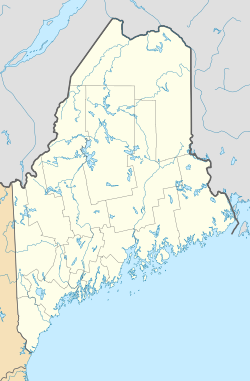
The Portland Museum of Art, or PMA, is the largest and oldest public art institution in Maine. Founded as the Portland Society of Art in 1882. It is located in the downtown area known as The Arts District in Portland, Maine.
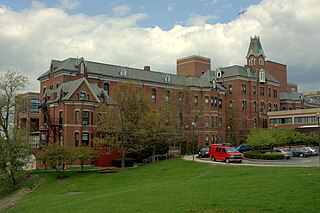
The West End is a downtown neighborhood in Portland, Maine. It is located on the western side of Portland's peninsula primarily on Bramhall Hill and is noted for its architecture and history. The neighborhood is home to many late 19th- and early 20th-century homes and, in 2010, it was called "one of the best preserved Victorian neighborhoods in the country". The Western Promenade, a park laid out in 1836, overlooks the forests and small settlements of Southwestern Maine, along with the distant White Mountains. Other historic structures include 68 High Street, The Gothic House, Brown House, Butler House, Ingraham House, Morrill Mansion and the Minott House.
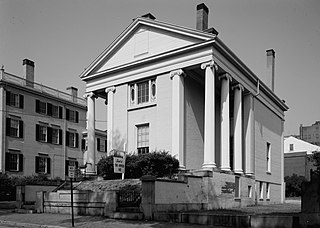
The Charles Q. Clapp House is a historic house at 97 Spring Street in central Portland, Maine. Built in 1832, it is one of Maine's important early examples of high style Greek Revival architecture. Probably designed by its first owner, Charles Q. Clapp, it served for much of the 20th century as the home of the Portland School of Fine and Applied Art, now the Maine College of Art. It is now owned by the adjacent Portland Museum of Art. It was listed on the National Register of Historic Places in 1972.
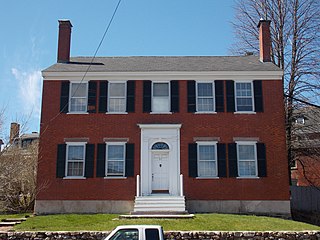
The Daniel How House is an historic house at 23 Danforth Street in Portland, Maine. Built in 1799, it is one of the oldest surviving residences on Portland's Neck, notably surviving the city's great 1866 fire. It is an excellent and well-preserved local example of Federal period architecture. It was listed on the National Register of Historic Places in 1973.

Baltimore Heritage is an American nonprofit historic-preservation organization headquartered in Baltimore, Maryland.

The Deering Street Historic District is a historic district in the Downtown and Parkside neighborhoods of Portland, Maine. Encompassing all of Deering Street and much of State Street, as well as adjacent portions of Congress and Mellen Streets, it is a cohesive collection of high quality architect-designed buildings from the second half of the 19th century, that were originally predominantly residential in nature. The district was added to the National Register of Historic Places in 1983.

The Hamblen Block is a historic series of four row houses at 188–194 Danforth Street in Portland, Maine, United States. Built in 1835, it is one of the oldest such buildings in the state, and also a rare example, as comparatively few row houses were built anywhere in Maine. The row houses were added to the National Register of Historic Places in 1983, and are a contributing property to the larger Hamblen Development Historic District.
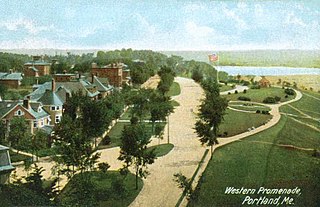
The Western Promenade is a historic promenade, an 18.1-acre (7.3 ha) public park and recreation area in the West End neighborhood of Portland, Maine. Developed between 1836 and the early 20th century, it is one Portland's oldest preserved spaces, with landscaping by the Olmsted Brothers, who included it in their master plan for the city's parks. The promenade was listed on the National Register of Historic Places in 1989.

The Western Promenade Historic District encompasses a late 19th-and early 20th-century neighborhood in the West End of Portland, Maine. This area of architecturally distinctive homes was home to three of the city's most prominent architects: Francis H. Fassett, John Calvin Stevens, and Frederick A. Tompson, and was Portland's most fashionable neighborhood in the late 19th century. The district was listed on the National Register of Historic Places in 1984.

The Charles Q. Clapp Block is a historic commercial building in Congress Square in downtown Portland, Maine. It occupies a prominent triangular site at the intersections of Congress, High and Free Streets. Built in 1826, to a design by prominent local architect and merchant Charles Q. Clapp, it is one of the oldest commercial buildings in Portland.

The Norway Historic District encompasses most of the historic village center of Norway, Maine, and is reflective of the town's growth over 150 years. Although significant early-to-mid 19th century buildings survive in the village, it was significantly damaged by a major fire in 1894, resulting in the construction of a number of new brick and wood-frame buildings. The district, which is 44 acres (18 ha) in size, includes 64 historically significant residential, civic, social, and commercial buildings, and was listed on the National Register of Historic Places in 1988.

The Wheelwright Block is a historic commercial building at 34 Hammond Street in Bangor, Maine. Built in 1859, it occupies a central position in the city's West Market Square at the junction of Main, Broad, and Hammond Streets. It was the state's first commercial Second Empire building, and notably survived both Bangor's devastating 1911 fire, and its major urban renewal programs of the late 1960s. It was listed on the National Register of Historic Places in 1974.

The Skowhegan Historic District encompasses the historic late 19th-century central business district of Skowhegan, Maine. The district is located on Madison Avenue and Water Streets on the north bank of the Kennebec River, and includes 37 historic buildings built between 1850 and 1910, including Skowhegan Town Hall, designed by John Calvin Stevens and built in 1909. The district was listed on the National Register of Historic Places in 1982.

The Belfast Commercial Historic District encompasses two blocks of the central business district of Belfast, Maine. This area includes the best-preserved and most architecturally interesting commercial buildings of the city's mid-to-late 19th century development, when it was the leading port on Penobscot Bay. It extends along Main Street from the major intersection and Church Street north to Washington Street. It was listed on the National Register of Historic Places in 1980, and is entirely contained within the larger Belfast Historic District.

The South Berwick Village Historic District encompasses the historic village center of South Berwick, Maine. First settled in the 1640s, the village developed along a major route between Boston, Massachusetts and Portland, Maine in the early 19th century. The village has about 150 years of architecture reflective of this history, and was listed on the National Register of Historic Places in 2010.

The Hamblen Development Historic District encompasses a modest collection of Greek Revival residential properties at 188–208 Danforth Street in Portland, Maine. They were built in 1835–36 as a speculative venture by members of the Hamblen family, and are a rare surviving cluster of development in the city from this period. The district was listed on the National Register of Historic Places in 1992.

The How Houses are a trio of Federal period houses on adjacent lots facing Danforth and Pleasant Streets in Portland, Maine. Built between 1799 and 1818, they are a surviving reminder of how the surrounding area was once developed; they are now surrounded by more modern commercial properties. They were listed as a group on the National Register of Historic Places in 1980; the Daniel How House was separately listed in 1973.

The Wiscasset Historic District is a 101-acre (41 ha) historic district that encompasses substantially all of the central village of Wiscasset, Maine. The district includes at least 22 contributing buildings and two other contributing sites, one being a cemetery whose oldest stone is from 1739. Located on the west bank of the Sheepscot River and settled in the 18th century, Wiscasset was a prominent harbor in Mid Coast Maine, and a major shipbuilding and merchant port, until the War of 1812 ended its prosperity. The village center includes fine examples of Federal period architecture, most built between about 1780 and 1820, including one National Historic Landmark, the Nickels-Sortwell House. The district was listed on the National Register of Historic Places in 1973.

The Waterville Main Street Historic District encompasses the best-preserved portions of the historical commercial downtown area of Waterville, Maine. Developed most intensively in the late 19th and early 20th centuries, this area was the center of commerce for Waterville and the surrounding rural communities. It encompasses 25 properties on Main and Common Streets, including the Waterville Opera House and City Hall. It was listed on the National Register of Historic Places in 2012, and was slightly enlarged in 2016.
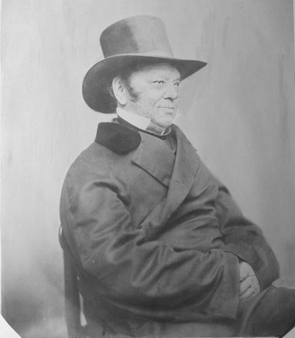
Charles Quincy Clapp was an American merchant and architect in Portland, Maine. He was active in the first half of the 19th century.

